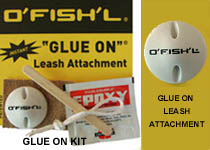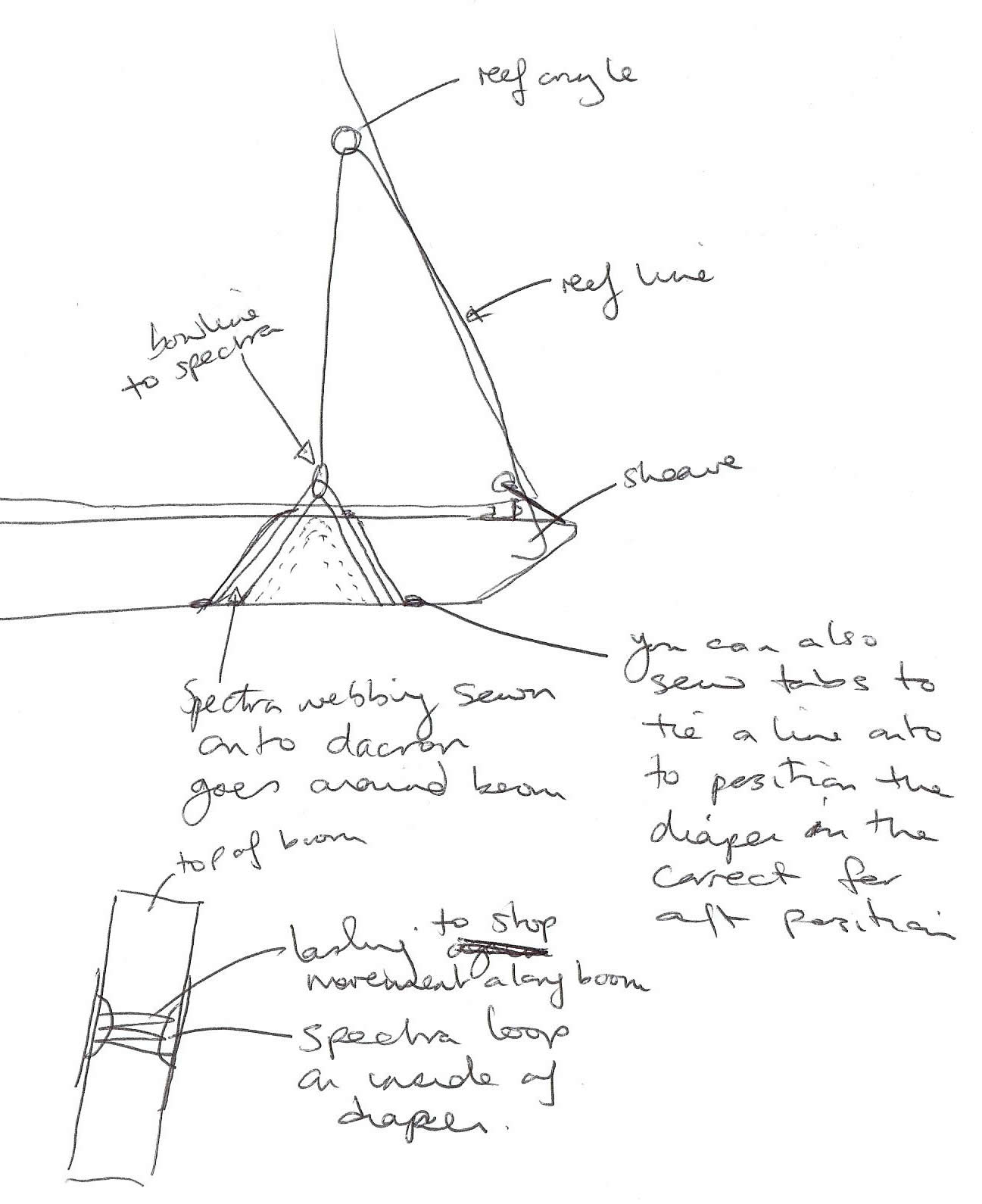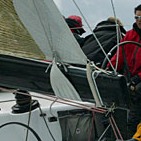Tips and tricks
Jib sheet in haulers
This inhauler is a simple sailmakers thimbel with a stainless bar tack welded to seperate the jib sheet from the inhauler. The edges are padded to stop any damage to the gel coat on the coach roof.

Tie Downs – ORC 2.03.2
2.03.2 Heavy items:
a) ballast, ballast tanks and associated equipment shall be permanently installed
b) heavy movable items including e.g. batteries, stoves, gas bottles, tanks, toolboxes and anchors and chain shall be securely fastened
c) heavy items for which fixing is not specified in Special Regulations shall be permanently installed or securely fastened, as appropriateÂ
I use padeyes from O’fishl and glue them on to the hull with 5200 you can also use thickened epoxy. A simple and quick way to comply with the rule.

Radar reflectors, sailing in fog
Several things effect how far away a vessel can be seen this is not a complete list but are the easiest to explain
1)output power of the unit a 16 mile radar is 1.5KW and a 24 mile unit is 3KW
2)heel angle at 15 degrees anything to windward is invisible and there is a significant blind spot to leeward unless the scanner is on a self leveling system
3)scanner height e.g. scanner is 5m off sea level and the target is 15 meters high the radar horizon is 13.5 miles away
4)atmospheric conditions
Radar reflectors some important points
1)mast shadowing – where ever it is mounted there is typically a 10 degree blind spot aft of the mast if it is mounted on the front. With movement of the vessel however, the return will be pretty consistent of at least 5 miles.
2)Material – some materials absorb (fiberglass absorbs 50% of the beam) others like steel and aluminum reflect even if there is some reflection it might be so erratic that it can”t be monitored on the screen.
3)Standards – 10 m2 is minimum in US reflectors must show range of 4 nm in calm sea.
4)Type –click here for the MAIB commissioned report on radar reflectors and also the MCA Guidance document
a)the octahedral if they are less than 18†wide are useless, shouldn”t be hoisted by the corner and even when it is hoisted correctly they have a blind spot of 120 degrees increasing to 180 degrees when heeled under sail you have a 50/50 chance of being seen
b)the mobri cylinders show nothing at all
c) if you have power and the money go with a Sea Me system it is the best on the market
c)RYM buys Echomax 230 I Inflatables see http://www.echomax.co.uk/Echomax_Products.htm
| ECHOMAX EM230+ | BLIPPER 210-7 | |
| RCS Peak m2 | 24m2 | April 2001 6.3m2 Nov 2001 7.96m2 |
| Response below peak | 12 peaks 20m2 @ 30 Degree intervals | Peaks – 4m2 & 5m2 |
| Performance @ 1.25m2 | 100% | 100% |
| Performance @ 2.5m2 | 100% | 54% |
| Performance @ 5m2 | 100% | 8% |
| Performance @ 10m2 | 70% | zero |
| + or – 3 Degrees heel | 24 sq.m @ 2.5m2- no nulls | 7.96 Seven nulls exceed 10 Degrees |
| + or – 9 Degrees heel | 19 sq.m peak @ 2.5m2 no nulls | 7.0 Seven nulls 28.5% (102.6 Degrees) |
| + or – 15 Degrees heel | 9 sq.m peak | 7.0 Seven nulls 45% (162 Degrees) |
| + or – 20 Degrees heel | 5 sq.m peak | Not tested |
| Overall length | 610 mm | 595 mm |
| Diameter | 248 mm | 240 mm |
| Distance between centres | EM-230 560 mm EM-220 BR (17m2) 545 mm |
545 mm |
| Weight | 2100 gr | 1879 gr |
| ISO 8729 | EXCEEDS | FAIL |
| RORC | EXCEEDS | FAIL |
| ORC | EXCEEDS | FAIL |
The above test results were obtained at QinetiQ (DERA) in April/November 2001 and May 2002.
7: Try to keep it vertical so if you are sailing and heeled over have two down lines one on each toe rail and you can use these to counter the heel to some extent.
The important things to do in fog is
1)The GPS can be more than 50 feet off so it is best to leave things at least ¼ mile off unless you have a radar
2)Keep moving don’t stop but go at a safe speed (rule 6)
3)Cross a shipping lane at the shortest point and as close to 90% as possible if you have to
4)Keep extra look out
5)Officially you should sound signals (I didn’t have it on the air horn yet but normally I tape the following onto the canister)
1.Long. Under power, making way (sound every 2 minutes)
2.Long, long. Under power, not making way (sound every 2 minutes)
3.Long, short, short. Towing, fishing, restricted ability to maneuver, sailing, and NUC (sound every 2 minutes)
4.Long, short, short, short. Manned vessel being towed (sound every 2 minutes)
5.Bell for 5 seconds At anchor (sound every minute)
6.Short, short, long. You are running into danger (also 5 shorts)
BTW: Number 6 is what I would expect to hear from that ship we were close by in the entrance to the bay if he had thought there was a problem…
6)Have the engine started
7)Listen on channel 16 and 13 in dual watch (I believe we were listening to 16 but not 13) 13 tells us vessel movements
8)Everyone with lifejackets on
9) Make Securite call on VHF if necessary
10)Alterations of course in general should be avoided after hearing a fog signal forward of the beam unless both position and movement of vessel have been determined as you could possibly present your boat into a t boning situation. See http://books.google.com/books?id=dgK3XYYhjeIC&pg=PA136&lpg=PA136&dq=altering+course+in+fog&source=web&ots=_0t80EgIUh&sig=kz90z9CZGlZP7PdOH9y2arIqbYU&hl=en&sa=X&oi=book_result&resnum=2&ct=result#PPA139,M1�
Reefing
If you think about having a reef in you should have one in. 9 out of 10 times you are faster with it in than heeling over and going sideways.
* single line reefing – good for short handed sailing but I agree it doesn’t allow great foot control.
* flattening reef (no change at the tack just takes a segment out by having a cringle on the leech)- some of the moore 24’s and express 27’s use them. Haven’t seen any on large offshore boats recently.
* slab reefing – I prefer this but I like to go with the more expensive approach of tylaska’s on a spectra strop attached to the pad eye on the side of the mast. You attach the tylaska to a ring which is sewn into the luff of the main. The advantage of this is that you don’t have to worry about the ring dropping off the horns at the mast especially if you are moving your cunningham after the reef has been put in. It is really important to have the strop at the right length so that you don’t mess with the tack set back as this can cause havoc with the groove in the rig. Last year I had a goove fail on a carbon rig when the strop was a inch too long – expensive mistake there were other things going on but that helped to exasebate (spelling!) the problem.
*reefing diapers – I use these on any booms where I am worried about the crush effect of wrapping a line around the boom. Also they mean you don’t have to worry about the placement of the reefing line along the boom. I don’t have a picture but imagine a piece of dacron in a diamond shape then sew on a piece of spectra webbing that follows the shape of the diamond with the join in the middle of the diamond and two loops extending from two opposite corners of the diamond. Then another piece of webbing on the inside which has loops that don’t extend beyond the material. You lash the diaper onto the boom using spectra laced through the loops of the shorter webbing – this allows you to put it in the correct position. You then attach the reef line to the loops that extend from the material.


*reefing cringles – I don’t believe it is ever good to tie up the extra material by going through the cringles and around the boom. The reason for this is if either your tack or clew blow you have a large chance of ripping the sail as the weight will be on the cringles. Also if it is dark and someone forgets to untie one you don’t have the same result. When you tie the bundle up if you have a loose footed main put the sail tie between the sail and the boom so if a tack or clew blows you just have a sausage foot blowing around. Also when I worked as a sailmaker they use to sew webbing with a loop in it onto a round piece of material than glue that to the sail creating a weak link whereby the loop or patch would fail before the sail would fail.
White collision flares
White flares are not distress flares they can be used for the following Â
– Â indicate your presence to a ship if there is a risk of collision.Â
– Â illumination at night in the case of a man over board but they destroy your night vision.
On my boats when going offshore I keep one flare velcroed to the handholds either side of the companionway so that if I need one quickly I just have to reach inside the companionway.
DSC Distress Call
I found a very useful form to fill out, laminate and post in your nav station it explains how to use the DSC Distress button on your VHF. For more information on DSC and for an online simulator of using it go to http://www.boatus.com/foundation/dsc/player.html
Morse Code
I came across a neumonic for memorizing Morse Code a few years ago and forgot about it until recently when I was doing some exams and needed to know a few of the sound signals. Of course I only memorized it for the exam and promptly forgot it!


